Mainamati
Mainamati an isolated ridge of low hills in the eastern margins of deltaic Bangladesh, about 8 km to the west of Comilla town is a very familiar name in our cultural heritage, where archaeological excavations have revealed very significant materials. A landmark of our ancient history, it represents a small mass of quasi-lateritic old alluvium. The ridge, set in the vast expanse of the fertile lower Meghna basin, extends for about 17 km north-south from Mainamati village on the Gumti River to Chandi Mura near the Lalmai railway station. In its widest parts, the ridge is about 4.5 km across and its highest peaks attain a height of about 45 metres. These highlands were once thickly wooded with an abundance of wild life, but modern developments have rudely disturbed its serene and idyllic setting.
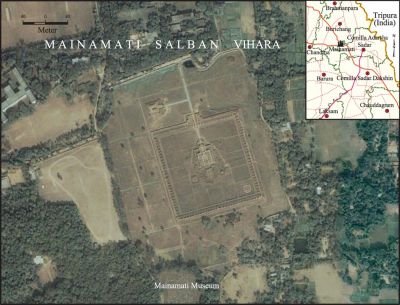
With an ever-expanding Cantonment at Mainamati, in the northern half of the ridge, and a fast growing township at Kotbari in about its centre, the fairy-tale beauty of the place is already a thing of the past.
The twin names - Lalmai- Mainamati - of the place have significant link with the past: Lalmai or the southern part is identical with Lalambi-vana of the Chandra epigraphs, while the northern part recalls the name of the legendary Chandra queen 'Maynamati', mentioned in local ballads and folk-songs. The archaeological finds have now established beyond any doubt that the cultural and political centre of ancient Vanga-Samatata (southeast Bengal) was located here. The glory and magnitude of that remarkable past is emphatically manifest in the innumerable monuments, mounds and excavated remains, adequately supplemented by an impressive array of stray finds from the area. Mainamati today is, however, better known for its Buddhist remains exposed by excavations. Here, indeed, lies the greatest assemblage of ancient Buddhist remains in Bangladesh.
The Discovery During the course of rebuilding the old axial road through these hills in 1875, workers accidentally uncovered the ruins of what at that time was thought to be 'a small brick fort'. It was actually a Buddhist monastery. Some 72 years earlier (1803), from the same area, was discovered the first Mainamati relic, the copperplate of Ranavankamalla Harikaladeva, dated 1220 AD, which records a description of the capital city of Pattikera as 'adorned with forts and monasteries'. The name now survives in the modern Patikara pargana of the locality.
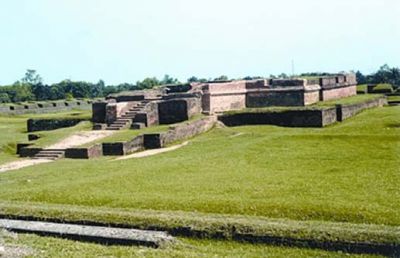
The Mainamati ruins were rediscovered during the Second World War. While setting up an advance camp, the military came across ancient remains at a number of points in the ridge. In the hurried survey that followed, 18 sites were recognised and protected by the government. In more regular and systematic surveys undertaken between 1955 and 1957, when the entire ridge was undisturbed by human occupation, more than 50 sites were located. Most of those sites lie in the northern half of the ridge, now within the Cantonment. Archaeological excavations started in January 1955. In several phases of excavation of the 50 odd sites nine have so far been exposed. Though the excavations have not yet been completed and have been limited in many respects, the results so far obtained and the information gained provide a sound archaeological basis for the reconstruction of the history and culture of the early period of this hitherto obscure region.
Excavated Sites Most important among the excavated sites is shalvan vihara, which lies about the middle of the ridge in the vicinity of the present day Bangladesh Academy for Rural Development (BARD) at Kotbari. Excavations have exposed a large paharpur type Buddhist monastery and a wealth of material objects datable from the 7th to 12th centuries AD. The discoveries from the site include eight inscribed copperplates, about 400 gold and silver coins, many terracotta and baked clay seals and sealings, a large number of sculptural specimens in stone, bronze and terracotta found in situ or otherwise. The grand monastery together with its central shrine was built by Shri Bhavadeva, the fourth ruler of the early deva dynasty of devaparvata, sometime towards the end of the 7th or early 8th century AD.

At kutila mura, the highest mound in the northeastern part of the ridge near ananda vihara, were unearthed the most attractive monuments in Mainamati The excavated monuments include three principal stupas and a number of subsidiary chapels and chaitya-halls built around them, all of which were enclosed by a massive boundary wall. Interesting and intricate structural forms and decorative styles have been preserved at the site. Excavations have not yet been completed here; the monastery in the northern end and two grand stupas in two wings of the site remain to be cleared yet. The excavated evidence suggests 7th century AD as the date of the beginning of these monuments. The site continued to be occupied till the 13th century AD as indicated by an Abbasid gold coin recovered from an upper level of the site.
charpatra mura is an interesting small site, situated in the northern part of the ridge in about the centre of the Cantonment area, where was uncovered the remains of a small Hindu temple dated in the Chandra period (10th-11th century AD). It is one of the earliest known examples of Hindu temple architecture in Bangladesh. Four copperplates were discovered in this monument and hence the name Charpatra Mura (four plates).

Largest among the Mainamati monuments is the Ananda Vihara. Situated in the archaeologically rich Kotbari central area, it represents a huge religious-cum-educational establishment of viharas, stupas and chapels all around. Together with the largest water tank in the area, this Vihara complex was built by Shri Anandadeva, the third ruler of the early Deva dynasty, sometime at the end of the 7th or beginning of the 8th century AD. Military contractors and brick hunters damaged this great establishment with its central shrine beyond recognition in 1944-45. Subsequently, the process of Cantonment building seriously affected the site. Excavations carried out here for a few seasons in the late seventies on a limited scale were incomplete in nature.
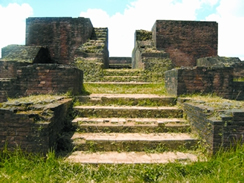
Next to Shalvan Vihara and Ananda Vihara, the third most important and extensive monastic establishment in Mainamati is the bhoja vihara, situated almost in the centre of the Kotbari area adjacent to BARD. A huge water tank lies on its east. Excavations have revealed the outlines of a square monastery with a large cruciform shrine in the centre of its open courtyard, very similar to Shalvan Vihara and Ananda Vihara.
Queen mainamati’s palace mound is the largest and highest mound in the northern extremity of the ridge near to the village that still bears the name of the queen, just east of Brahmanbaria road. The site is traditionally associated with the legendary Chandra queen Mainamati, mother of the last-known Chandra king, govindachandra. Excavations on a limited scale have uncovered here parts of a massive defense wall round different parts of the site, probably a citadel, and the corner of a substantial structure, probably a palace, at the centre of the site. This is probably the only site in Mainamati that has revealed structures of secular nature.

Next to Shalvan Vihara and Ananda Vihara, the third most important and extensive monastic establishment in Mainamati is the bhoja vihara, situated almost in the centre of the Kotbari area adjacent to bard. A huge water tank lies on its east. Excavations have revealed the outlines of a square monastery with a large cruciform shrine in the centre of its open courtyard, very similar to Shalvan Vihara and Ananda Vihara.
Queen 'Mainamati's Palace Mound is the largest and highest mound in the northern extremity of the ridge near to the village that still bears the name of the queen, just east of Brahmanbaria road. The site is traditionally associated with the legendary Chandra queen Mainamati, mother of the last-known Chandra' king, govindachandra. Excavations on a limited scale have uncovered here parts of a massive defense wall round different parts of the site, probably a citadel, and the corner of a substantial structure, probably a palace, at the centre of the site. This is probably the only site in Mainamati that has revealed structures of secular nature.
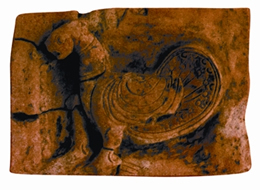
rupban mura, an important site, lies on a hillock between modern Bard and BGD (former BDR) establishments in the Kotbari area on the south of the Comilla-Kalirbazar road. Excavations have revealed here the remains of a remarkable semi-cruciform shrine together with other subsidiary structures. Deep diggings have revealed three main periods of building and rebuilding, the earliest of which correspond to c.6th -7th centuries AD. Very little of the last period remains (10th-11th centuries AD) survive now in this very heavily disturbed site. Significant discoveries from the site include, besides the colossal stone Buddha, five debased gold coins of Balabhatta, the Khadga ruler.
The archaeological remains of itakhola mura lie in three terraces on the hillock opposite to the Rupban Mura site across the Kotbari road. It served for long as a quarry for old bricks and hence the name. Excavations have revealed here a grand stupa complex with an attached monastery to its north. Of the five cultural phases the earlier three lie buried underneath the later remains. Mentionable antiquities from the site, besides the stucco image, are three round pellets of solid gold (19 tolas) and a copperplate, which is still to be deciphered.
Just near the Mainamati Bus Stop, north of the Dhaka-Chittagong highway, lies mainamati mound 1a, where limited excavations have revealed six long walls, straight and cross roads, gateways and other scant remains. The non-religious and secular features of the remains suggest the existence of a garrison barrack here.
Unexcavated Sites Among the many unexcavated sites, mention may be made of the Bairagir Mura, a medium sized high mound directly to the west of Kutila Mura in the Cantonment. Brickbats, potsherds and fragments of stone images found scattered on the surface strongly indicate its archaeological importance. The site has been badly damaged by the construction of two huge water tanks on its top for water supply to the Cantonment. A number of objects were discovered during construction work; only two (dated in the Chandra period) have found their place into the local museum - the lower part of an inscribed colossal stone image standing on a lotus throne, and the bronze life-size head of a Bodhisattva image.
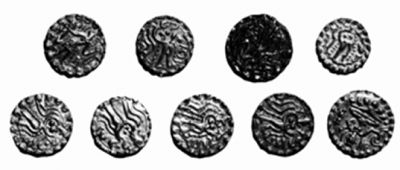
The discovery of a colossal bronze bell, large dressed stone square blocks (presumably pillar bases), one copperplate, and one stone plaque inscriptions, and a number of bronze and terracotta sculptures clearly indicate the importance of the Rupban Kanya Mura, situated in the middle of the Kotbari area. But the site has now been levelled to accommodate the parade ground and garages of the Cantonment.
The Kotbari Mound showed clear traces of a Shalvan Vihara type monastery with a cruciform shrine in the centre. A grand mosque and its attached graveyard have taken over the site.
Pakka Mura is an important unexcavated site (274m x 91m, 15m high) on the western edge of the ridge, about a mile and a half southwest of the Kotbari ruins. The importance of the site lies in its subsequent extension to its lower base on the west, presumably after the river had dried out or changed its course. A part of the silted up riverbed was turned into a huge water reservoir called Tara Dighi (a large tank named Tara), the deeper central part of which has now been turned into two modern tanks. While constructing the larger tank, about two acres in size, two interesting black stone images of Visnu, one life-size and the other slightly smaller, showing mature Sena-Deva characteristics, were found. Among other associated finds most significant is a copperplate inscription of Dasharathadeva (13th century), son and successor of Damodaradeva of the later Deva dynasty.
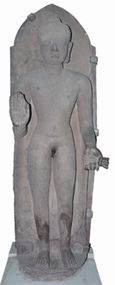
The extensive high mound on the western edge of the ridge, about 2.5 km to the northwest of the southernmost site of Chandi Mura, locally known as Rupban Mura, had visible structural remains in the shape of a circular dome at the top of the mound. Removal of bricks by local inhabitants has already caused destruction of the exposed structural remains. The site has the potential of yielding important remains.
At the extreme southern end of the ridge, about 1.6 km to the northwest of Lalmai railway station is a prominent mound (457m ' 183m, 18m high), locally called Chandi Mura. The site derives its name from the twin temples of Chandi built on the summit of the mound, some 250 years back by a Maharaja of Tripura. The archaeological character of the site is undisturbed; the mound probably contains the remains of a large temple. The top of the mound was badly damaged, first by the construction of the Chandi temples, and later by modern constructions undertaken by people associated with the temples. However, the archaeological remains at the lower levels may still be intact.
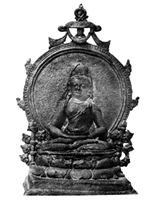
Among other unexcavated sites, mention may be made of Mainamati Mound 2, Abbas Ali Mura, Station Commander's Residence, Hatigara Mound, Ujirpur Mound, Ghila Mura and Balaghazir Mura. All these sites have yielded evidence of remains of archaeological importance. Most of these sites are now in bad shape due to willful or unwillful negligence of the people occupying the mounds or their neighbourhood.
Antiquities The Mainamati excavations have yielded an exceptionally rich harvest of valuable antiquities including twelve copperplate grants and shorter image-inscriptions, over 400 gold and silver coins, innumerable terracotta and clay seals and sealings, some Neolithic stone axes and chisels, a large collection of stone, bronze, stucco and terracotta sculptures, stone and terracotta beads, gold, silver and bronze ornaments, decorative terracotta and architectural pieces, metal and earthenware pots, pans, vases and utensils, oil lamps and a variety of other objects of everyday use. The majority of these objects comes from Shalvan Vihara, the most systematically excavated site. Together, they contribute significantly to our knowledge of ancient Vanga-Samatata, covering a period of about seven hundred years from the 6th to 13th centuries AD.
No fewer than twelve copperplate grants have been recovered from the excavations, which throw most welcome light on the history, culture, society, and economy of southeastern Bengal. Among the many short dedicatory or votive inscriptions the few bearing the original name of Shalvan Vihara and its royal builder are very significant.
Mentionable among the numismatic finds are a few Gupta and post-Gupta imitation gold coins, a rare silver coin of shashanka, about a dozen gold coins of the Khadga ruler Balabhatta, few Arakanese and hundreds of harikela and 'Akara' dynasty coins, and one gold, and a few silver coins of Abbasid Caliphs.
The sculptural finds in stone, bronze, stucco and terracotta represent the largest single group of antiquities other than pottery. Stone sculptures are rare, but include a fine stucco sculpture though damaged, it is an interesting specimen. The bronzes primarily represent religious art and show a perplexing variety of iconographic types, revealing the gradual transformation of the popular faith Mahayana to Tantric and ultimately to polytheistic forms in which Buddhism became inextricably mixed with Hindu and aboriginal elements. The sculptured terracotta plaques are the most numerous, attractive and representative of local folk art. They are remarkable both for their crude but vigorous style and local characteristics.
About a dozen ground and polished narrow-butted hand-axes and chisels, mainly of fossil wood, have been recovered from the excavations. Recent explorations have uncovered a few Neolithic settlements in the southern part of the Mainamati ridge. The collected specimens must have originally come from there. They show clear affinity with the Neolithic industries of West Bengal, Bihar and Orissa.
Mainamati excavations have, thus, thrown a flood of light on almost every aspect of the life and culture of the southeastern part of Bengal. It has supplied detailed information regarding the social, political and economic condition of the region and has led to the discovery of the remarkable early Deva dynasty and of Balabhatta, the founder of Devaparvata.
It has settled a number of historical and geographical questions, for instance, concerning the extent and bounds of Samatata, the location of Devaparvata, Pattikera and Lalambi-vana (jungle), and the situation of Harikela.
More important, with the studies and analysis of terracotta and the classification and sequence dating of the pottery types and other common objects, Mainamati has now provided set a workable basis for further investigations and research in the field. Mainamati finds have no doubt broadened the horizon of our understanding of our past.
The primary significance of this collection lies in the fact that it represents the only available authentic and contemporary stratified materials from southeast.
Bengal that provide for the first time a dependable archaeological basis for the reconstruction of the history and civilisation of this region of Bengal. [M Harunur Rashid]
